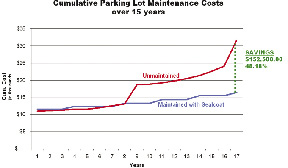For the professional property manager, a preventive maintenance plan translates into significant savings over reactively managing property issues. A preventive parking lot maintenance plan can greatly extend the longevity of parking surfaces, while improving the overall appearance of a commercial property.
A visitor to your property, whether a potential buyer, tenant, or customer, begins to develop an impression of you and your building when first driving into the parking area. Attractive parking areas, with fresh black surfaces, neat line striping and well-maintained curbs go a long way to ensure that the first impression is the right impression. Preventive pavement maintenance makes good economic sense on both sides of the balance sheet.
Timely Maintenance Saves Dollars
What is the most cost effective time cycle for performing pavement maintenance? The answer depends on local climate and the age and condition of the asphalt surface. For that reason, we provide our customers with a free periodic inspection of their parking surfaces and assist them in establishing a schedule and budget for necessary pavement service and repair.
Pavement damaged by sun, salt, and snow plowing will continue to deteriorate in the summer sun. Spider web cracks and potholes started by the winter freeze thaw cycles will expand from vehicle traffic, water penetration, and heat expansion. Once pavement damage has started, it tends to progress at an increasing rate. The sooner problems are addressed, the greater the cost savings.
One critical element in any pavement maintenance plan is the regular sealing of cracks to prevent water from penetrating to the base soil. The best protection against water penetration is sealing all cracks with a hot-applied rubberized joint sealant that meets federal specifications. The superior flexibility and durability of this product, even at very low temperatures, allow it to block water seepage through cracks even under the harshest winter conditions.
The second critical element in any pavement maintenance plan is Sealcoating on a three-year cycle. Sealcoat may either be an asphalt emulsion or a latex-based coal tar pitch emulsion fortified with additives and sand. It provides a durable barrier to both the elements and fuel/oil leaks. The primary benefit of sealcoat is that it greatly slows the whole asphalt degradation process. The natural destruction of paved surfaces begins with solar ultraviolet oxidation of the asphalt binder, leading to shrinkage and cracking. Sealcoat is an effective sunblock for your pavement.
Cut and Patch the Potholes
Areas of spider-web cracks and broken pavement most often occur where simple linear cracks have been neglected and not properly sealed. Water penetration and winter freeze-thaw cycles widen the cracks, and the damage progresses at an accelerating pace. Eventually the pavement breaks through completely and potholes form.
Areas that have spider webbed cracks or potholes are beyond the point of cracksealing. These areas must be cut square, ripped out, regraded, and then repaved with 1.5" of bituminous binder, followed 1.5" of bituminous topcoat asphalt. Edges must be emulsified to bond the new pavement to the old.
The Economic Value of Sealcoating
Property managers employing a sound preventive pavement maintenance plan have enjoyed a savings of more than 48% (or $152,500 for a standard commercial parking lot), according to a study by the University of Nevada, Reno Pavement Coatings Center, as compared to asphalt surfaces that are "reactively" repaired or replaced once damage has occurred. The pavement that was crackfilled and sealcoated at three-year intervals remained in serviceable condition at the end of the 15-year test period. The untreated asphalt required significant and costly paving work twice during the same 15-year test period.
Don't budget asphalt maintenance in the blind. Talk with a reputable paving contractor and request both a free pavement analysis, and a preventative maintenance savings plan with detailed budget figures. These are guaranteed to simplify life for the property owner or manager.
Tags:










